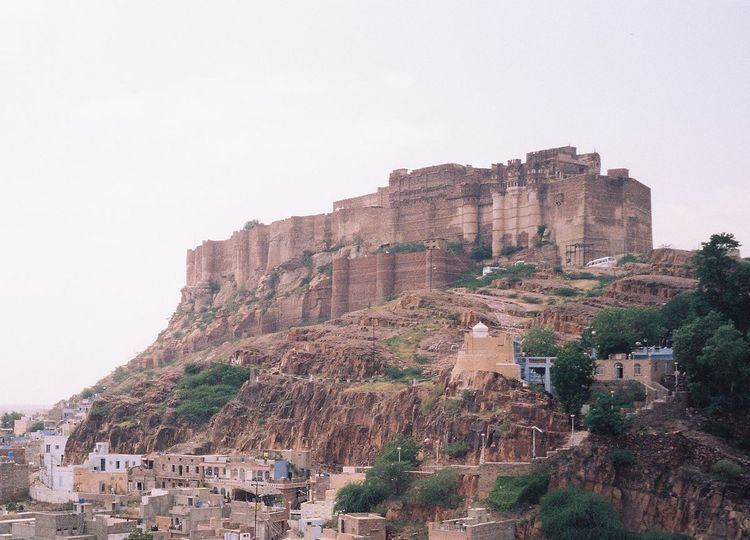Reign c. 1427 – c. 1489 Died April 6, 1489 Father Rao Ranmal Parents Rao Ranmal | Name Jodha Mandore Children Rao Bika Role Architect Structures Mehrangarh Fort | |
 | ||
Born 28 March 1416 ( 1416-03-28 ) | ||
Rao Jodha (28 March 1416 - 6 April 1489) was an Indian ruler of Mandore in the present-day state of Rajasthan. He was the son of Rao Ranmal (Ranamalla) of the Rathore clan. He is known for founding the city of Jodhpur in 1459.
Contents
- Ancestry
- Early years
- Legend about capture of Mandore
- Later conquests
- Foundation of JodhagarhJodhpur
- Death and the succession
- References
Ancestry
Rao Ranmal secured the throne of Mandore in 1427. In addition to ruling Mandore, Rao Ranmal also became the administrator of Mewar to assist Maharana Mokal (father of Rana Kumbha). After the assassination of Maharana Mokal by two brothers (Chacha and Mera) in 1433, Ranmal continued as administrator of Mewar at the side of Rana Kumbha.
Early years
Approximately 700 horsemen accompanied Rao Jodha from Chittor. Fighting near Chittor and a valiant attempt to bar the pursuers at Someshwar Pass resulted in heavy losses amongst Jodha's warriors. When Jodha reached Mandore he had only seven people accompanying him. Jodha collected whatever forces he could, abandoned Mandore and pressed on towards Jangalu. Jodha barely managed to reach safety at Kahuni (a village near present-day Bikaner). For 15 years Jodha tried in vain to recapture Mandore. Jodha's opportunity to strike finally came in 1453 with Rana Kumbha facing simultaneous attacks by the Sultans of Malwa and Gujarat. Jodha made a surprise attack on Mandore using horses seized from the Thakur of Setrawa and other jagirdars. Jodha's forces overwhelmed the defenders and captured Mandore with relative ease. Jodha then successively captured Chaukade, Sojat, Merta, Bahirunda and Kosana(Rishi Dadhichi's origin). Rana Kumbha did make attempts to recapture these territories, albeit unsuccessfully. Jodha and Kumbha eventually settled their differences in order to face their common enemies, the rulers of Malwa and Gujarat.
Legend about capture of Mandore
Once, late at night, Rao Jodha stopped at a farmers house.They did not recognize who he was. He was given a bowl of hot khichdi, an Indian stew. Jodha put his fingers in the centre of the bowl and burnt his fingers. The farmer's wife commented, "Stranger, you are making the same mistake as our king (Jodha) is. Khichdi is hottest in the centre and coolest at the edge". This prompted Jodha to stop worrying about Mandore and just focus on outlying forts, which he managed to win with ease. In due time he captured Mandore.
Later conquests
According to Nainsi's Vigat (Marwar ra parganam ri vigat) the rulers of Jalore and Bundi submitted to Rao Jodha. Ajmer and Sambhar were ceded to Jodha by Rana Kumbha's son, Udaysimha (Udaysingh I). The ruler of Mohilavati, Ajit Singh died in a battle with Rao Jodha's forces and the city was captured some years later. After settling down in the aforementioned village of Kahuni, Jodha's son Bika founded a new state. Jodha thus controlled two thirds of the Marwar region and also Bikaner.
Foundation of Jodhagarh/Jodhpur
A holy man sensibly advised Rao Jodha to move the capital to hilltop safety. By 1459, it became evident that a more secure headquarters was required. Chidia-tunk, a high rocky ridge, nine km to the south of Mandore was an obvious choice for the new city of Jodhagarh. The natural elevation was enhanced by a fortress of staggering proportions, to which Rao Jodha's successors added over the centuries. Jodhagarh was on the important Delhi to Gujarat trade route and it greatly benefited from the trade of silk, opium, sandalwood, copper and other items. The Mehrangarh Fort, situated on a 125 m high hill, is among the most impressive and formidable forts in Rajasthan. The construction of the fort was begun by Maharaja Rao Jodha in 1459 and was completed by Maharaja Jaswant Singh (1637–1680).
The fort originally had seven gates ("pols"). There is a first gate with spikes to prevent attack from elephants. The Fatehpol or victory gate was erected by Maharaja Ajit Singh in 1707 to commemorate his victory over the Mughals. The other gates include the Jayapol, built by Maharaja Man Singh in 1806, following his victory over the armies of Jaipur and Bikaner.
Death and the succession
Rao Jodha died on 6 April 1489, aged 73. The death of Rao Jodha was followed by a struggle for succession amongst his sons. He was succeeded by his son Rao Satal (1489–1491). After his death, his brother Rao Suja (1491–1515) occupied the throne.
